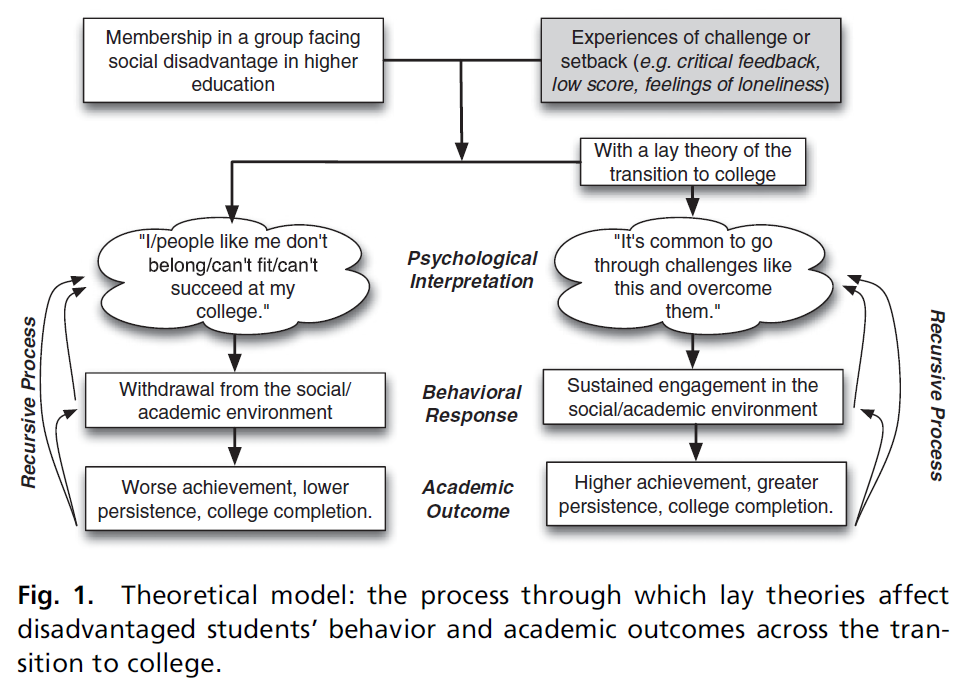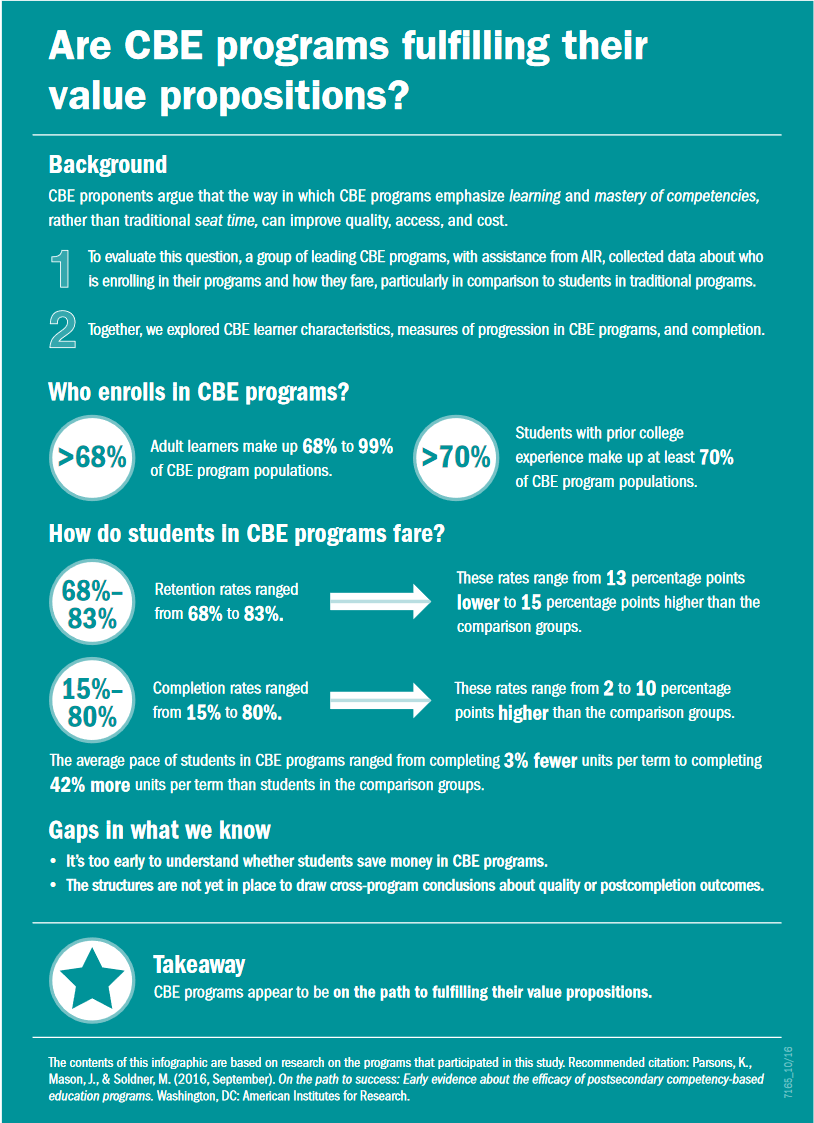Commentary
A month or so ago Dr. Tom Green and I were chatting while driving back from Madison to Chicago, and he mentioned reading something in a New York Times op-ed about the results of three lay theory experiments, which piqued my interest because of the simplicity and apparent success of the intervention. These experiments were designed to measure the effectiveness of lay theory pre-matriculation interventions in helping freshmen overcome feelings of doubt that they have the means to succeed in college and therefore improve success (see figure below). One of the pre-matriculation interventions involved sharing upperclassmen’s “accounts of how they navigated the shoals of university life.” I set about trying to find the original research and it took several weeks for me to track it down in the Proceedings of the National Academy of the Sciences.
The results of the experiments are very interesting and seem to have identified a fairly low-cost and highly effective intervention to help disadvantaged students close the achievement gap. The authors summarize their results thusly, “The lay theory interventions raised first-year full-time college enrollment among students from socially and economically disadvantaged backgrounds exiting a high-performing charter high school network or entering a public flagship university (experiments 1 and 2) and, at a selective private university, raised disadvantaged student cumulative first-year grade point average (experiment 3). These gained correspond to 31-40% reductions of the raw (unadjusted) institutional achievement gaps between students from disadvantages and non-disadvantages background and those institutions.”

Source:
http://www.pnas.org/content/113/24/E3341
AACRAO Research Insights
To round out the AACRAO career profile report series, we just deployed the chief admissions officer survey. This survey closes on November 4th, and the report should be available by early December. The November 60-Second survey (being deployed Oct. 31st through Nov. 4th) is a collection of practice questions we have received from our members over the last several months—each of which are interesting and/or timely but on their own did not make a complete 60-Second survey. Topics include how institutions capture last-day-of-attendance for financial aid, drop/add period lengths, automatic awarding of degrees without the need to apply for graduation, use of shadow-terms for freshmen, use of a computer literacy assessment for incoming students, and others.
These two surveys are being deployed on our new survey platform Qualtrics. We have also built the AACRAO Core Professional Competencies as two self-assessments. These will be beta tested with SEM attendees. The intent is to tie the various competencies and proficiencies with conference sessions. Future enhancements aim to tie the assessments to the professional development resources available from AACRAO.
Invitation to Share your Institution’s Practices
DOL Overtime Rule and Your Campus
Congress recently proposed several new measures to delay the implementation of the Department of Labor's overtime rule, but failed to approve formally the legislation before breaking for recess. We expect a return to this issue after lawmakers return to Washington following the elections. We also expect President Obama to veto any delay if such a bill were to pass.
With the new requirements currently slated to take effect on December 1, we know many campuses have questions about implementation strategies and what other institutions are doing to comply with the new requirements. Has your institution developed a plan? Would you be willing to share how your institution intends to deal with different positions in its offices? If so, please email Quintina Barnett Gallion, AACRAO’s Assistant Director of Communication and Legislative Affairs.
Current Higher Education Research and Related Topics
Data from the National Center for Education Statistics (NCES) Indicates a Continuing Tendency in Undergraduate Enrollment towards Nontraditional Students
Data from 2011-2012 National Postsecondary Student Aid Study (NPSAS) revealed that “about 74%” of all undergraduates applying for financial aid had at least one characteristic typically attributed to nontraditional students and almost a third had 2-3 characteristics. This data has not change much since 1995-1996. “Is it time to rethink the term nontraditional student?”
Pearson Finds that Many Adult Students Return to College to Keep Pace with Technology and Advancements in their Field
Pearson conducted its first Adult Learners Survey of over 1,500 US adults either already enrolled in college or planning to enroll. The results of Pearson’s study revealed that most are not concerned with being replaced by younger workers or concerned about their job being outsourced to another country. However, most (72%) noted that advancements in their field have led them to seek additional education to keep up. In addition, more than two-thirds (69%) believe that their job will change significantly in the next five years due to technological advancement.
Returns to Vocational Credentials: Evidence from Ohio’s Community and Technical Colleges
The CAPSEE authors found the following:
- associate degrees generate positive earnings effects for both men and women, and the effects are strongest in health
- certificates also generate positive returns with some gender differences
Performance Standards in Need-Based Student Aid
The National Bureau of Economic Research recently released a report (available for a small fee for non-member institutions) examining the consequences of Satisfactory Academic Progress (SAP) failure. The data supported theoretical predictions that in the short term there are “negative impacts on persistence but positive impacts on grades for students who remain enrolled.” In the longer term, the negative effects of the policy/practice overshadow the positive. The authors also found that SAP “appears to exacerbate inequality in higher education by pushing out low-performing low-income students faster than their equally low-performing, but higher income peers.”
College Students Want More Learning Technology
McGrawHill Education surveyed more than 3,000 students about the role of technology in their learning. Among other discoveries, the report authors found that:
- "84% of students report that the use of technology improves their education
- 81% report that digital learning technology helps save them time and be more efficient
- 81% claim that digital learning technology is helping them boost their grades
- 89% agreed that learning tech ‘should respond and adapt to my unique way of learning’
- 61% prefer classes that use digital learning technology”
Brookings Institution Race Disparity in Student Load Debt After Graduation
Report authors Judith Scott-Clayton and Jin Li found that there is a $7,400 average greater debt load between black and white college graduates immediately after graduation. This gap more than trebles in the next several years. Taking into account interest accruals and graduate school borrowing, black students have almost twice as much debt four years after graduation at almost $53,000. The authors “provide new evidence that racial gaps in total debt are far larger than even recent reports have recognized . . .” and identify policy implications.
Two New Reports on Competency-Based Education (CBE)
Competency-Based Education: A Study of Four New Models and Their Implications for Bending the Higher Education Cost Curve
The rpkGroup completed a Lumina Foundation-funded first look report on four business models for CBE. The study findings suggest that CBE can lower the cost of instructional delivery and may offer a faster pathway to “demonstrate content mastery.” However, it will likely take several years for an institution to see revenue numbers that match operating expenses and their significant up-front costs.
One Path to Success: Early Evidence about the Efficacy of Postsecondary Competency-Based Education (CBE) Programs
The American Institutes for Research collaborated with CBE leaders at six institutions to help answer the following questions about CBE: 1) Who is enrolling in CBE programs?; 2) What outcomes did those students achieve, and how did they compare with students in traditional programs?; and 3) What data are being used, when gaps existed, and what else would be needed to better address these questions? An infographic from the paper summarizes their early findings.
